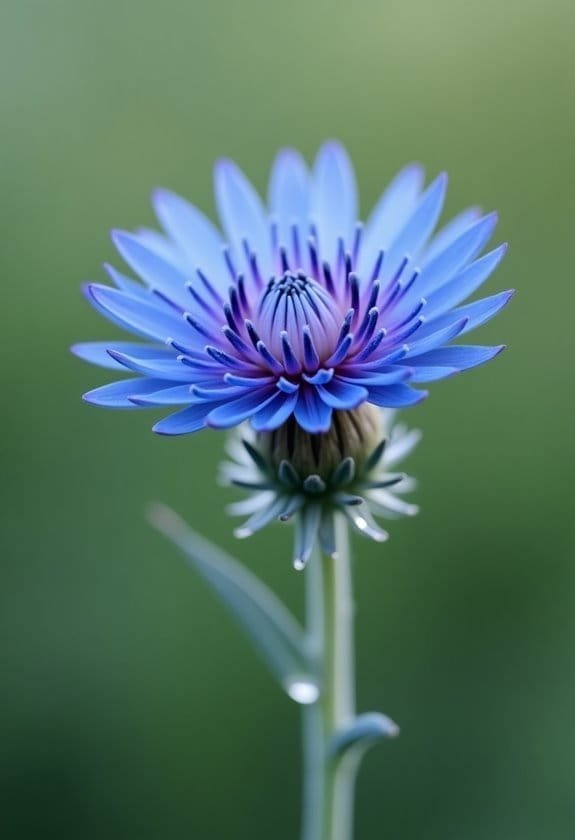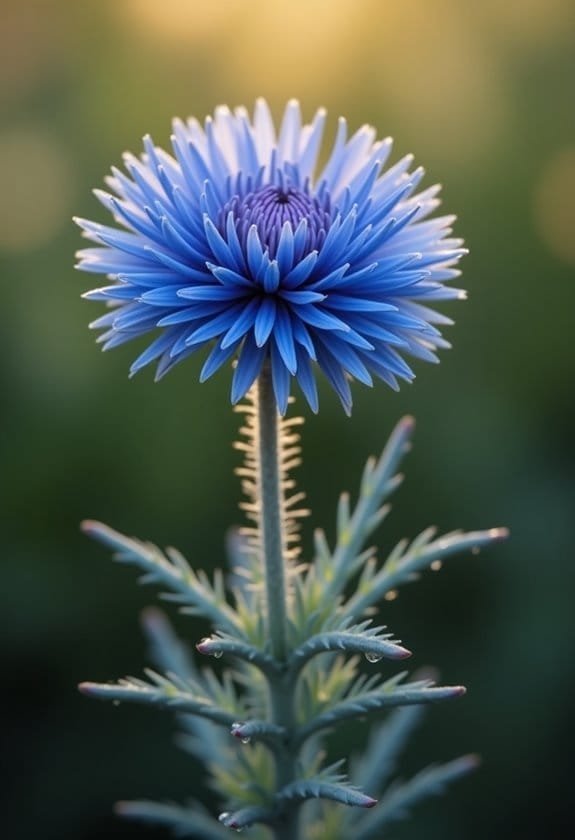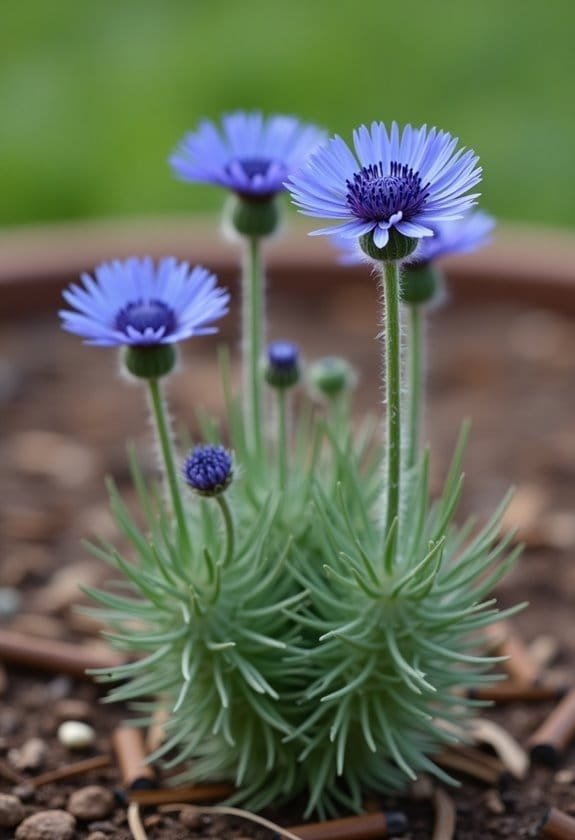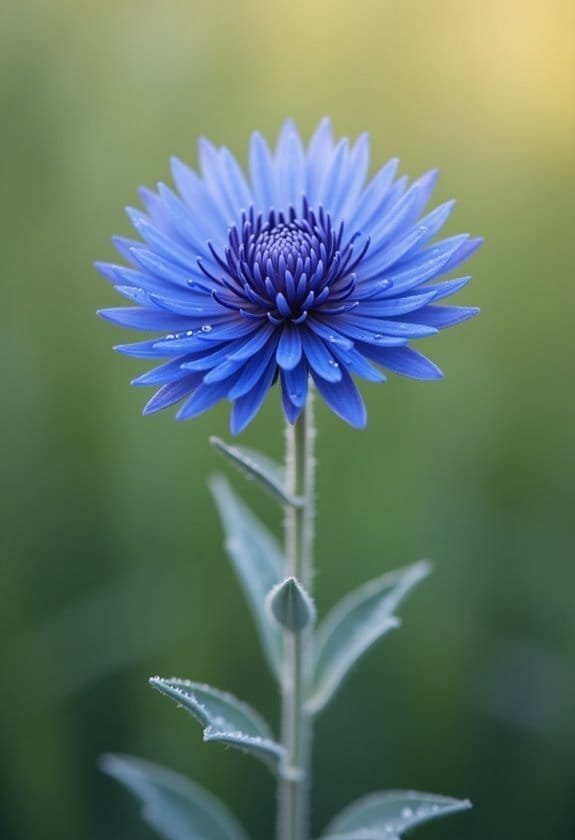Cornflower (Centaurea cyanus) is a resilient annual plant that grows 20-100 cm tall, featuring distinctive blue flowers containing the pigment protocyanin. It's adapted to temperate climates and thrives in well-draining soil with pH levels between 6.0-8.0, demonstrating impressive drought tolerance once established. The plant's grey-green stems and lanceolate leaves create an attractive vertical presence, while its 1.5-3 cm flower heads serve as essential nectar sources for pollinators throughout its late spring to early fall blooming period. Beyond its ornamental appeal, cornflower carries rich cultural significance as the national flower of Germany and Estonia, while offering valuable ecological and culinary applications worth exploring.
Main Points
- Cornflower is an annual flowering plant with distinctive blue blooms measuring 1.5-3 cm in diameter, featuring the unique pigment protocyanin.
- Growing 20-100 cm tall, it requires full sun to partial shade and well-draining soil with pH levels between 6.0-8.0.
- Known as Bachelor's Button, it serves as the national flower of Germany and Estonia, holding significant cultural and historical importance.
- The plant attracts pollinators like bees and butterflies, supporting biodiversity while providing extended blooming from late spring through early fall.
- Edible flowers are used in culinary applications, herbal teas, and traditional medicine, offering both decorative and potential therapeutic benefits.
Introduction

The cornflower (Centaurea cyanus) stands as one of Europe's most distinctive wildflowers, recognized worldwide for its striking blue blooms and slender, branching stems.
This annual plant, which reaches heights between 20 to 100 centimeters, showcases flower heads measuring 1.5 to 3 centimeters in diameter and contains a unique blue pigment called protocyanin.
Beyond its botanical significance, the cornflower holds deep cultural importance as Germany's national flower and serves essential ecological functions by supporting pollinators while offering both culinary and medicinal applications.
Common Name
Known across cultures by various enchanting names, cornflower carries deep historical and cultural significance throughout Europe and beyond. Among its most widespread appellations, Bachelor's Button reflects the flower's traditional use in buttonholes worn by young men seeking romance, while Bluebottle pays homage to its distinctive azure hue.
The charming moniker Witches Bells emerged from medieval folklore, where the plant's delicate blooms were believed to possess mystical properties that could both attract and ward off supernatural forces.
These vernacular names showcase the remarkable diversity of cultural interpretations that have shaped the cornflower's identity across different regions and historical periods. In scientific circles, the plant's designation as Centaurea cyanus combines its genus classification with a Latin reference to its striking blue coloration, bridging the gap between folk tradition and botanical taxonomy.
The flower's multiple names serve as linguistic windows into its rich cultural heritage, from its romantic associations in Old English tradition to its profound political symbolism in German history and its status as Estonia's cherished national flower.
Scientific Name
Scientifically classified as Centaurea cyanus, cornflower belongs to the diverse Asteraceae family, which encompasses numerous flowering plants worldwide. The species designation holds significant meaning, as "cyanus" derives from ancient Greek terminology, directly referencing the plant's characteristic blue blooms that have captivated botanists and gardeners alike.
The taxonomic classification of Centaurea cyanus reflects its distinct genetic makeup, featuring a diploid chromosome count of 2n = 24, which contributes to its remarkable adaptability across various environments. This genetic structure has enabled the species to maintain robust populations throughout its native temperate European range and beyond, as it's now cultivated globally with considerable success.
Research has revealed that Centaurea cyanus populations exhibit substantial genetic diversity, a characteristic that proves essential for their long-term survival and evolution.
This intrinsic variation within the species has allowed it to adapt to different growing conditions and environmental pressures, making it both resilient and versatile in various ecological contexts. Such genetic richness continues to interest botanists studying plant adaptation and evolution in changing climates.
Overview
Among Europe's most cherished wildflowers, cornflower (Centaurea cyanus) stands out with its vibrant azure blooms and rich cultural heritage. This remarkable annual plant graces temperate European landscapes with its striking blue flowers from late spring through early fall, reaching heights between 20 and 100 centimeters.
The plant's distinctive characteristics include its grey-green branched stems and graceful lanceolate leaves, which span 3 to 10 centimeters in length. With a diploid chromosome count of 2n = 24, cornflower demonstrates impressive genetic diversity, enabling it to adapt and thrive across varying environmental conditions.
Beyond its aesthetic appeal, the species serves as a crucial ecological cornerstone, providing sustenance for pollinators and contributing to local biodiversity.
Cornflower's significance extends well beyond its natural attributes, as it holds deep cultural resonance across Europe. In Germany, it's celebrated as a national floral emblem, while in France, it's forever linked to World War I veterans as a symbol of remembrance.
The plant's versatility is further enhanced by its edible flowers, which not only add visual appeal to culinary creations but also offer potential therapeutic benefits through their anti-inflammatory properties.
Key Features
The cornflower stands out in gardens with its striking blue flowerheads, which measure 1.5-3 cm in diameter and grace the landscape from late spring through early fall.
Growing to impressive heights between 20-100 cm, this annual plant features distinctive grey-green stems that branch elegantly throughout its structure.
The plant's lanceolate leaves, stretching 3-10 cm in length, complement its overall architectural form, creating a visually balanced appearance that has long captivated gardeners and naturalists alike.
Growth Size
Standing gracefully in gardens and meadows, cornflowers showcase impressive vertical growth ranging from 20 to 100 centimeters (8 to 39 inches) in height, complemented by a modest spread of 15 to 30 centimeters (6 to 12 inches). Their slender stems support striking blue flower heads that measure 1.5 to 3 centimeters in diameter, creating a delicate yet commanding presence in any garden setting.
The plant's architectural framework includes precisely arranged lanceolate leaves, stretching 3 to 10 centimeters in length, which add a sophisticated grey-green backdrop to the vibrant blooms. These proportions allow cornflowers to function effectively as both standalone specimens and cooperative companions in mixed borders, where their vertical elements create natural sight lines through the garden landscape.
While the taller varieties may require strategic support through staking, their overall growth pattern remains remarkably self-sufficient. The plant's adaptable nature means it maintains these impressive dimensions across various light conditions, from full sun to partial shade, while developing a robust structure that's both aesthetically pleasing and practically manageable in diverse garden designs.
Appearance
Instantly recognizable by their brilliant blue blooms, cornflowers captivate with their distinctive appearance and charming simplicity. The striking flowerheads, measuring between 1.5 and 3 centimeters in diameter, showcase the plant's signature blue coloring, which derives from a unique pigment called protocyanin, setting it apart from the red pigments found in many other flowers.
While the blue cornflower is most celebrated for its classic azure hue, the species demonstrates remarkable variation in its color palette, occasionally producing blooms in pink, lavender, white, and deep maroon tones.
The plant's overall structure presents an elegant silhouette, with grey-green stems branching gracefully upward and adorned with lance-shaped leaves spanning 3 to 10 centimeters in length. These slender leaves complement the flowers' delicate appearance while providing a subtle contrast to the vibrant blooms above.
The plant's genetic makeup, characterized by a diploid chromosome count of 2n = 24, contributes to its diverse morphological expressions, allowing for subtle variations in appearance across different populations.
Flowering Season
During their peak flowering season from late spring through early fall, cornflowers paint gardens and meadows with spectacular blooms that persist for several months. These resilient plants produce striking flower heads measuring 1.5 to 3 centimeters in diameter, creating a mesmerizing display of mainly intense blue blossoms.
The flowering phase commences once the plants achieve their mature height, which ranges from 20 to 100 centimeters depending on environmental conditions and genetic variations. As the season progresses, these elegant blooms transform gardens into vibrant sanctuaries for various pollinators, enhancing local biodiversity through their extended flowering period.
Gardeners can maximize the duration of this colorful display through strategic deadheading practices, which not only promotes continuous blooming but also prevents excessive self-seeding throughout the garden space. This management technique guarantees that the cornflowers maintain their ornamental impact while contributing to the garden's ecological balance.
The plants' reliable flowering pattern and extended blooming period make them valuable additions to both formal gardens and naturalized meadow settings, where their azure blooms create striking visual focal points throughout the warm-weather months.
Growing Requirements

Cornflowers thrive with abundant sunlight exposure, though they can tolerate partial shade in warmer climates.
They adapt remarkably well to various soil conditions, preferring well-draining ground with moderate fertility, and can establish themselves successfully in everything from average garden soil to relatively poor earth.
While these resilient plants demonstrate excellent drought tolerance once established, providing consistent moisture during their initial growth phase and occasional water during prolonged dry spells will promote ideal flowering and overall plant vigor.
Light
Abundant sunlight plays an essential role in growing healthy cornflowers, as these striking blooms require at least 6 hours of direct sun daily.
These enchanting flowers have evolved to thrive in open, sun-drenched locations, where they can harness maximum solar energy for robust growth and prolific flowering.
While cornflowers demonstrate some adaptability to light shade, their performance considerably diminishes without adequate sunlight exposure.
Plants grown in shadier conditions often develop elongated, weak stems that struggle to support their characteristic azure blooms, resulting in a less appealing, sprawling growth habit.
The intensity of their signature blue petals also depends greatly on sufficient light exposure, with full sun locations producing the most vibrant, eye-catching displays.
For gardeners in regions with shorter growing seasons or cooler climates, providing ideal sunlight becomes even more critical.
Full sun exposure enables cornflowers to establish strong root systems and develop sturdy stems more quickly, leading to a longer and more productive blooming period.
When selecting a planting location, prioritizing areas that receive unobstructed sunlight throughout the day will guarantee these beloved flowers reach their full potential.
Soil
Beyond the need for plentiful sunlight, proper soil conditions form the foundation for thriving cornflowers. These resilient plants demonstrate remarkable adaptability across various soil compositions, including environments that might challenge more sensitive species. Their versatility extends to contaminated and nutrient-poor soils, making them excellent candidates for rehabilitation projects and challenging garden spaces.
The ideal growing medium for cornflowers is well-drained soil that maintains moderate moisture levels without becoming waterlogged. While they show impressive drought tolerance once established, consistent watering during their early development stages helps create robust root systems.
The plants' pH tolerance spans from mildly acidic to alkaline conditions, specifically within the 6.0 to 8.0 range, allowing them to flourish in diverse garden settings. This adaptability to soil chemistry makes cornflowers particularly valuable for gardeners working with varying soil profiles.
For peak growth, incorporating organic matter into the planting area can enhance drainage while retaining essential moisture, though these hardy plants don't demand extensive soil amendments to perform well in most garden situations.
Water
Proper water management plays an essential role in cultivating healthy cornflowers, though these resilient plants don't demand constant attention to thrive. Their adaptable nature allows them to withstand periods of drought once they've established themselves in the garden, making them remarkably low-maintenance additions to any landscape.
While cornflowers demonstrate impressive drought tolerance, providing consistent moisture during dry spells can greatly enhance their flowering potential and overall vigor. Gardeners should focus on delivering water directly to the plant's base, avoiding overhead irrigation that might create favorable conditions for fungal development.
Morning watering proves particularly beneficial, as it gives any excess moisture adequate time to evaporate throughout the day.
These hardy plants strike an admirable balance between resilience and responsiveness to care. Though they can persevere through periods of limited water availability, extended drought conditions may result in diminished blooming and reduced growth rates.
Regular monitoring of soil moisture levels, particularly during flowering periods, helps maintain ideal growing conditions without risking overwatering, ensuring these beautiful blooms reach their full potential.
Temperature
Successful cornflower cultivation depends largely on providing the right temperature conditions throughout their growing season. These resilient flowers thrive best in cooler climates, where temperatures consistently hover between 15°C and 25°C (59°F to 77°F), creating an ideal environment for robust growth and abundant blooming.
While cornflowers demonstrate remarkable adaptability, plants may need protection during extreme temperature fluctuations to maintain their vigor. Their adaptable nature allows them to withstand brief periods of both warmer and cooler conditions, making them particularly suitable for temperate garden zones.
During the establishment phase, maintaining steady temperatures helps guarantee strong root development and subsequent flowering success.
For best results, gardeners should time their planting schedule according to local temperature patterns. Starting seeds indoors 6-8 weeks before the final frost provides seedlings with controlled temperature conditions during their vulnerable early stages.
Once transplanted outdoors after frost danger has passed, these hardy plants readily acclimate to seasonal temperature variations while maintaining their characteristic azure blooms. Their tolerance for moderate temperature stress contributes to their reputation as low-maintenance garden favorites.
Pollinator Criteria
Cornflowers serve as essential pollinator magnets in the garden, attracting an array of beneficial insects with their striking blue blooms and abundant nectar resources.
The plant's open flower structure allows easy access for both long-tongued bees and butterflies, while its extended blooming period from late spring through early fall provides consistent foraging opportunities.
These remarkable flowers support pollinator populations through natural reseeding and drought tolerance, creating sustainable habitats that contribute to the broader ecosystem's health and biodiversity.
Attracted Pollinators
The magnetic allure of Centaurea cyanus stems from its ability to attract diverse pollinators throughout the growing season. The plant's distinctive blue flowers serve as beacons for numerous beneficial insects, particularly during its extended blooming period from late spring through early fall.
Bees and butterflies are particularly drawn to cornflowers, thanks to the flowers' accessible architecture and abundant nectar production. The open structure of the flower heads allows pollinators to easily navigate and collect resources, making these blossoms particularly efficient for both the insects and the plants themselves.
This mutual benefit creates a sustainable relationship that enhances garden biodiversity.
The presence of cornflowers in garden settings has demonstrated significant positive effects on pollinator populations, as these plants act as reliable food sources during essential foraging periods. Their contribution to the ecosystem extends beyond mere aesthetics, as they create important habitats that support various beneficial insects throughout their life cycles, ultimately strengthening the intricate web of garden ecology through increased pollinator activity and sustained environmental health.
Pollination Method
Orchestrating a precise pollination process, Centaurea cyanus relies on specialized flower structures that guide insect visitors to their nectar rewards. The plant's distinctive tubular design creates an efficient pathway for pollinators, particularly bees and butterflies, to access the rich nectar stores hidden within.
The pollination method of cornflowers demonstrates remarkable adaptation to their insect partners, as the flowers' structure has evolved to accommodate various pollinator species throughout their extended blooming season. When insects land on the cornflower's petals, they encounter a perfectly sized entrance that leads them directly to the nectar source, guaranteeing contact with the plant's reproductive structures during their visit.
This strategic positioning guarantees successful pollen transfer as the insects move from flower to flower. From late spring through early fall, this pollination mechanism maintains peak efficiency, synchronizing perfectly with the active periods of their primary pollinators.
The result is a highly effective reproductive strategy that not only guarantees the cornflower's survival but also contributes to the broader ecosystem by providing essential resources for numerous pollinator species throughout the growing season.
Care & Maintenance

Cornflowers thrive in well-drained soil with full sun exposure, making their initial planting location essential for establishing healthy root systems and promoting vigorous growth.
Regular deadheading and strategic staking of taller varieties help maintain the plants' aesthetic appeal, while their drought-tolerant nature means minimal watering is required once they're established.
These resilient bloomers partner beautifully with complementary flowers like cosmos and black-eyed susans, creating dynamic garden displays that attract beneficial pollinators throughout the growing season.
Planting Tips
Growing healthy cornflowers starts with selecting the right location and soil conditions. These resilient plants thrive in areas that receive full sun exposure, though they can tolerate partial shade in warmer climates. Well-draining soil is vital for successful cultivation, and cornflowers demonstrate remarkable adaptability to both average and nutrient-poor soil conditions.
For best results, gardeners can choose between two primary planting approaches. Indoor seed starting should commence 6-8 weeks before the final frost date, providing seedlings with a strong head start for the growing season. Alternatively, direct sowing outdoors becomes viable once frost risks have subsided, typically in early spring.
When planning the garden layout, it's important to take into account that taller varieties will require support structures to prevent stem collapse during maturity. Space plants approximately 6-8 inches apart to guarantee adequate air circulation and prevent overcrowding.
While establishing new plantings, maintain consistent soil moisture until the roots develop fully. Once established, these hardy annuals demonstrate impressive drought tolerance, making them an excellent choice for low-maintenance garden designs.
Ongoing Care
Successful maintenance of cornflowers relies on a few key practices that promote healthy growth and abundant blooming. The ongoing care of these resilient plants begins with a conservative watering schedule, as established specimens demonstrate remarkable drought tolerance, making them ideal candidates for water-conscious gardens.
Regular deadheading emerges as an essential maintenance task, encouraging extended flowering periods while preventing excessive self-seeding that could lead to unwanted spread throughout the garden.
Taller varieties benefit from strategic staking, particularly in locations exposed to strong winds or when growing in less-than-optimal light conditions, which helps maintain their upright, dignified stance.
While cornflowers generally exhibit robust pest resistance, gardeners should watch for aphids and mealybugs, addressing any infestations promptly to preserve plant health.
Maintaining proper soil moisture proves important, though these adaptable plants prefer well-draining conditions over consistently wet soil.
Through these straightforward yet significant care practices, cornflowers reward gardeners with their striking blue blooms and reliable performance throughout the growing season.
Suggested Companions
When planning your garden layout, selecting the right companion plants for cornflowers can enhance their growth and create a visually stunning display. The harmonious combination of daisies and cosmos alongside cornflowers not only creates an aesthetically pleasing arrangement but also attracts vital pollinators that benefit the entire garden ecosystem.
For peak companionship success, cornflowers naturally complement drought-resistant plants such as lavender and yarrow, as they share similar water requirements once established. These partnerships create a sustainable and low-maintenance garden arrangement that thrives in well-drained soil conditions.
Marigolds serve as particularly beneficial companion plants, acting as natural defenders against common cornflower pests like aphids and mealybugs through their pest-deterrent properties.
When designing companion plantings, it's crucial to take into account the soil pH requirements of 6.0 to 8.0 and verify all selected plants share similar sunlight needs of at least six hours daily. This thoughtful combination of companion plants not only supports the cornflowers' growth but also contributes to a more resilient and biodiverse garden environment that sustains itself through natural ecological relationships.
What Are the Differences Between Corncockle and Cornflower in Appearance and Habitat?
Corncockle and cornflower differ significantly in appearance and habitat. Corncockle features delicate, purple-pink flowers and thrives in open fields, while cornflower boasts vivid blue petals, often found in meadows. The corncockle agrostemma githago plant profile highlights its slender stems and toxic seeds, contrasting with the wildlife-friendly cornflower’s robust and safe nature.
Common Issues
While cornflowers are generally hardy plants, they can face challenges from common garden pests like aphids and mealybugs, which feed on their stems and leaves.
These resilient flowers typically withstand most disease pressures, though they may occasionally encounter issues with wilts, rots, or rust infections that can compromise their vigor.
Regular monitoring and proper spacing between plants will help prevent most pest and disease problems, with organic insecticidal soaps offering an effective solution for persistent insect infestations.
Pests/Diseases
Despite their natural resilience, cornflowers can face several pest and disease challenges that gardeners should monitor. Common pests like aphids and mealybugs pose potential threats to these otherwise hardy plants, often clustering on stems and leaves to extract crucial nutrients.
Fortunately, these unwanted visitors can be effectively managed by encouraging beneficial insects or applying gentle remedies like insecticidal soap.
On the disease front, cornflowers might encounter various fungal issues, including wilts, rots, and rusts, though these rarely cause considerable damage to healthy specimens.
The key to preventing such problems lies in maintaining ideal growing conditions and following proper cultural practices. Ensuring adequate air circulation between plants and implementing appropriate watering routines can greatly reduce the likelihood of fungal infections taking hold.
Regular monitoring serves as the cornerstone of effective pest and disease management, allowing gardeners to identify and address potential issues before they become severe.
When combined with proper plant spacing and careful attention to soil drainage, these preventative measures help maintain the vibrant beauty and health of Centaurea cyanus throughout its growing season.
Solutions
The most common issues affecting cornflowers can be effectively addressed through simple, targeted solutions. To combat inbreeding depression in fragmented populations, establishing connectivity corridors between isolated patches helps maintain genetic diversity and guarantees robust reproduction patterns.
For agricultural settings where cornflowers emerge as problematic weeds, implementing integrated weed management strategies proves crucial. Early detection combined with mechanical removal before seed formation considerably reduces crop yield losses, while targeted herbicide application serves as a last resort in severe cases.
In regions where cornflowers display invasive tendencies, regular monitoring and strategic containment measures help prevent their spread into vulnerable ecosystems.
Garden enthusiasts can maintain healthy cornflower displays through consistent deadheading practices, which not only controls unwanted self-seeding but also encourages continuous blooming throughout the growing season.
When pest problems arise, natural solutions such as introducing beneficial insects or applying insecticidal soaps effectively manage aphid and mealybug infestations without compromising the plant's overall health or its value to beneficial pollinators in the garden ecosystem.
Summary

Cornflower stands as a striking annual plant native to temperate Europe, distinguished by its vibrant blue blooms and adaptable nature. This remarkable species, reaching heights of 20-100 cm, has established itself as both a beloved ornamental flower and, in some contexts, a challenging agricultural companion.
The plant's impressive genetic diversity, characterized by its diploid chromosome count of 2n = 24, contributes to its resilience and adaptability across various environments. Its reproductive capabilities are equally significant, with each plant producing approximately 800 seeds, enabling efficient natural propagation throughout suitable habitats.
Beyond its aesthetic appeal, cornflower demonstrates significant versatility in its applications. The species boasts meaningful medicinal properties, particularly its anti-inflammatory effects, while also serving as an edible plant that enhances both culinary presentations and nutritional value.
Despite facing challenges from modern agricultural practices and habitat loss, cornflower continues to captivate botanists and gardeners alike with its distinctive grey-green foliage and characteristic blue blooms that grace gardens from late spring through early fall.


